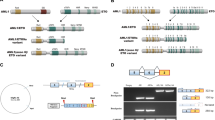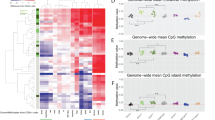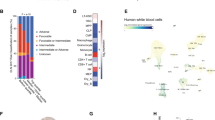Abstract
Retroviral insertional mutagenesis in BXH2 mice commonly induces myeloid leukemias. One of the most frequently involved genes in experimental studies is Meis 1. In contrast to other genes in murine models, Meis 1 has not been affected by recurrent chromosomal translocations or point mutations in human leukemias. We found a constant downregulation of the Meis 1 gene mRNA in AML1-ETO acute myeloid leukemias and in those cases harboring in frame mutations in the bZIP domain of CEBPα. The absence of the Meis 1 mRNA was not caused by inactivating point mutations in the coding sequence. Promoter hypermethylation was present in more than half of the cases (9/14), including samples obtained from the widely employed Kasumi-1 cell line. Double treatment with 5-Aza-2′-deoxycytidine and trichostatin A of the Kasumi-1 cell line partially reverses Meis 1 inhibition. HoxA9 levels were also low. In a cell line model (U937 Tet AML1-ETO), AML1-ETO expression was not associated with Meis 1 suppression at 72 h. Nevertheless, Meis 1 repression is dependent on the AML1-ETO transcript levels in treated leukemic patients. Chimeric products that arise from chromosomal translocations may be associated with locus-specific epigenetic inactivation. It remains to be investigated when this methylation process is acquired and which are the basic mechanisms underlying these molecular events in AML1-ETO and CEBPα-mutated AML.
This is a preview of subscription content, access via your institution
Access options
Subscribe to this journal
Receive 12 print issues and online access
$259.00 per year
only $21.58 per issue
Buy this article
- Purchase on Springer Link
- Instant access to full article PDF
Prices may be subject to local taxes which are calculated during checkout






Similar content being viewed by others
References
Speck NA, Gilliland DG . Core-binding factors in haematopoiesis and leukemia. Nat Rev Cancer 2002; 2: 502–551.
Yuan Y, Zhou T, Miyamoto T, Iwasaki H, Harakawa N, Hetherington CJ et al. RUNX1-ETO expression is directly involved in the development of acute myeloid leukemia in the presence of additional mutation. Proc Natl Acad Sci USA 2001; 98: 10398–10403.
Thorsteinsdottir U, Kroon E, Jerome L, Blasi F, Sauvageau G . Defining roles for Hox and Meis 1 genes in induction of acute myeloid leukemia. Mol Cell Biol 2001; 21: 224–234.
Calvo KR, Knoepfler PS, Sykes DB, Pasillas MP, Kamps MP . Meis1a suppresses differentiation by G-CSF and promotes proliferation by SCF: potential mechanisms of cooperativity with HoxA9 in myeloid leukemia. Proc Natl Acad Sci USA 2001; 98: 13120–13125.
Imamura T, Morimoto A, Takanashi M, Hibi S, Sugimoto T, Ishii E et al. Frequent co-expression of HoxA9 and Meis 1 genes in infant acute lymphoblastic leukaemia with MLL rearrangement. Br J Haematol 2002; 119: 119–121.
Moskow JJ, Bullrich F, Huebner K, Daar IO, Buchberg AM . Meis 1, a PBX1-related homeobox gene involved in myeloid leukemia in BXH-2 mice. Mol Cell Biol 1995; 15: 5434–5443.
Li J, Shen H, Himmel KL, Dupuy AJ, Largaespada D, Nakamura T et al. Leukemia disease genes: large-scale cloning and pathway predictions. Nat Genet 1999; 23: 348–353.
Smith JE, Bollekens JA, Inghirami G, Takeshita K . Cloning and mapping of the MEIS 1 gene, the human homolog of a leukemogenic gene. Genomics 1997; 43: 99–103.
Gabert J, Beillard E, van der Velden VHJ, Bi W, Grimwade D, Pallisgaard N et al. Standardization and quality control studies of ‘real time’quantitative reverse transcriptase polymerase chain reaction (RQ-PCR) of fusion gene transcripts for minimal residual disease detection in leukemia – A Europe Against Cancer Program. Leukemia 2003; 17: 2318–2357.
Pabst T, Mueller BU, Zhang P, Radomska HS, Narravula S, Schnittger S et al. Dominant-negative mutations of CEBPA, encoding CCAAT/enhancer binding protein-alpha (C/EBPalpha), in acute myeloid leukemia. Nat Genet 2001; 27: 263–270.
Song WJ, Sullivan MG, Legare RD, Hutchings S, Tan X, Kufrin D et al. Haploinsufficiency of CBFA2 causes familial thrombocytopenia with propensity to develop acute myelogenous leukemia. Nat Genet 1999; 23: 166–175.
Burel SA, Harakawa N, Zhou L, Pabst T, Tenen DG, Zhang DE . Dichotomy of AML1-ETO functions: growth arrest versus block of differentiation. Mol Cell Biol 2001; 21: 5577–5590.
Darzynkiewicz Z, Juan G . Analysis of DNA content and BrdUrd incorporation. In: Robinson P, Darzynkiewicz Z, Dean P, Orfao A, Rabinovitch P, Stewart C, Tanke H, Wheeless L (eds). Curr Protocols Cytometry, New York, NY: Current Protocols/Wiley-Liss, 1998, Section 7.7, pp 7.7.1–7.7.6.
Muñoz L, Nomdedeu JF, Villamor N, Munoz L, Guardia R, Colomer D et al. Acute myeloid leukemia with MLL rearrangements: clinicobiological features, prognostic impact and value of flow cytometry in the detection of residual leukemic cells. Leukemia 2003; 17: 76–82.
Cameron ER, Bachman KE, Myöhänen S, Herman JG, Baylin SB . Synergy of demethylation and histone deacetylase inhibition in the re-expression of genes silenced in cancer. Nat Genet 1999; 21: 103–107.
Toyooka S, Carbone M, Toyooka KO, Bochetta M, Shivapurkar N, Minna JD et al. Progressive aberrant methylation of the RASSF1A gene in simian virus 40 infected human mesothelial cells. Oncogene 2002; 21: 4340–4344.
Tsai CN, Tsai CL, Tse KP, Chang HY, Chang YS . The Epstein–Barr virus oncogene product, latent membrane protein 1, induces the down-regulation of E-cadherin gene expression via activation of DNA methyltransferases. Proc Natl Acad Sci USA 2002; 99: 10084–10089.
Amann JM, Nip J, Strom DK, Lutterbach B, Harada H, Lenny N et al. ETO, a target of t(8;21) in acute leukemia, makes distinct contacts with multiple histone deacetylases and binds mSin3A through its oligomerization domain. Mol Cell Biol 2001; 21: 6470–6483.
Hug BA, Lee S, Kinsler E, Zhang J, Lazar MA . Cooperative function of RUNX1-ETO corepressor recruitment domains in the expansion of primary bone marrow cells. Cancer Res 2002; 62: 2906–2912.
Rangatia J, Vangala R, Treiber N, Zhang P, Radomska H, Tenen DG et al. Downregulation of c-Jun expression by transcription factor C/EBPα is critical for granulocyte lineage commitment. Mol Cell Biol 2002; 22: 8681–8694.
Pabst T, Mueller BU, Harakawa N, Schoch C, Haferlach T, Behre G et al. RUNX1-ETO downregulates the granulocytic differentiation factor C/EBPα in t(8;21) myeloid leukemia. Nat Med 2001; 7: 444–451.
Martin ME, Milne TA, Bloyer S, Galoian K, Shen W, Gibbs D et al. Dimerization of MLL fusion proteins immortalizes hematopoietic cells. Cancer Cell 2003; 4: 197–207.
Wang J, Saunthararajah Y, Redner RL, Liu JM . Inhibitors of histone deacetylase relieve ETO-mediated repression and induce differentiation of AML1-ETO leukemia cells. Cancer Res 1999; 59: 2766–2769.
Klisovic MI, Maghraby EA, Parthun MR, Guimond M, Sklenar AR, Whitman SP et al. Depsipeptide (FR 901228) promotes histone acetylation, gene transcription, apoptosis and its activity is enhanced by DNA methyltransferase inhibitors in AML1/ETO-positive leukemic cells. Leukemia 2003; 17: 350–358.
Di Croce L, Raker VA, Corsaro MM, Fazi F, Fanelli M, Faretta M et al. Methyltransferase recruitment and DNA hypermethylationof target promoter by an oncogenic transcription factor. Science 2002; 295: 1079–1082.
Acknowledgements
This study was supported by grants from the Fondo de Investigaciones Sanitarias (FIS) (PI020509 and GO3/10). U937 Tet AML1-ETO cell line was kindly provided by Dr DE Zhang, Scripps Research Institute, La Jolla, CA.
Author information
Authors and Affiliations
Corresponding author
Additional information
Supplementary Information accompanies the paper on Leukemia website (http://www.nature.com/leu).
Supplementary information
Rights and permissions
About this article
Cite this article
Lasa, A., Carnicer, M., Aventín, A. et al. MEIS 1 expression is downregulated through promoter hypermethylation in AML1-ETO acute myeloid leukemias. Leukemia 18, 1231–1237 (2004). https://doi.org/10.1038/sj.leu.2403377
Received:
Accepted:
Published:
Issue Date:
DOI: https://doi.org/10.1038/sj.leu.2403377
Keywords
This article is cited by
-
HOXA9 has the hallmarks of a biological switch with implications in blood cancers
Nature Communications (2022)
-
Epigenetic silencing of downstream genes mediated by tandem orientation in lung cancer
Scientific Reports (2017)
-
Predicting the molecular role of MEIS1 in esophageal squamous cell carcinoma
Tumor Biology (2016)
-
RUNX1 meets MLL: epigenetic regulation of hematopoiesis by two leukemia genes
Leukemia (2013)
-
Salivary Gland Cancers: Biology and Molecular Targets for Therapy
Current Oncology Reports (2012)



